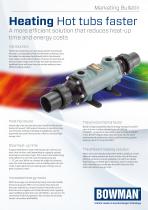 Website:
Bowman
Website:
Bowman
Catalog excerpts

Marketing Bulletin Heating Hot tubs faster A more efficient solution that reduces heat-up time and energy costs Introduction The hot tub market has seen spectacular growth over the past few years. Led originally by ‘high end’ domestic and leisure users, the market has developed significantly both in the domestic mass market and the leisure industry. However, the slow heat-up times and high energy costs of many hot tubs have become a significant factor and many users are actively seeking a more efficient heating solution. Heating issues Historically, most hot tubs have been installed with electric heaters of around 3 kW output. However, in operation many users find this method of heating unsatisfactory, due to extremely slow pool heat-up times, which in turn lead high energy costs. Slow heat-up time A typical 3kW electric heater will require up to 24 hours to heat a hot tub from cold (depending on capacity, outside temperature and heater type). This is due to the heater being only sufficient to raise the water temperature by just 1 - 2ºC per hour. Whilst an irritation for single tub domestic users, for multi-tub operators, such as holiday parks, this can create major logistical issues during guest change-over at peak occupancy times. Based on figures published by the Energy Savings Trust (EST), electricity has a carbon dioxide factor of 0.496 kg CO2/kWh*, compared to gas, which is just 0.184 kg CO2/kWh*. In fact the EST’s figures show that electricity has the worst environmental performance when used for heating, beaten even by coal at 0.315 kg CO2/kWh.* The efficient heating solution Many users have already realised the need to switch to a more efficient heating solution for their hot tubs. One of the most efficient solutions currently available is to switch to a boiler fired heat source (either gas or biomass), used in conjunction with a Bowman heat exchanger that both heats hot tubs faster and reduces energy costs. Increased energy costs With the average cost of electricity being more than double the price of gas per kWh*, it’s no surprise that many hot tub users experience a sharp increase in electricity costs, if their tubs are in regular use. Private domestic users regularly report additional electricity costs of £500.00 + per annum. For commercial multi-tub operators, this increase can seriously impact on business profitability. A World Leader in Heat Exchanger Tec
Open the catalog to page 1
Marketing Bulletin How does the system work? In many ways the operation is similar to that of a conventional swimming pool system. Basically, there are two separate water circuits – the heating circuit and the pool water circuit. The use of a Bowman heat exchanger ensures the water in these two circuits is always kept separate from each other, avoiding corrosion to the boiler internals and contamination of the hot tub water. Heated water from the boiler (shown in red on the adjacent illustration) is pumped to the heat exchanger inlet, where it flows through the unit in a counterflow...
Open the catalog to page 2All Bowman catalogs and technical brochures
-
Gen-Set Efficiency
2 Pages
-
TITANIUM Heat Exchangers
2 Pages
-
Charge Air Coolers
8 Pages
-
Swimming Pool Heat Exchangers
12 Pages
-
Header Tank Heat Exchangers
16 Pages
-
Bowman Fire Pumps
2 Pages
-
'C' Coat 300 End Covers
1 Pages
-
Shell and Tube Heat Exchangers
12 Pages
-
Inline Plate Heat Exchangers
2 Pages
-
Non-storage Calorifiers
2 Pages
-
DC Oil coolers
4 Pages
-
Header Tank Heat Exchangers
12 Pages
-
Hydraulic Oil Coolers
20 Pages
-
Marine Heat Exchangers
26 Pages
-
Mining industry oil coolers
2 Pages
-
Test House Heat Exchangers
1 Pages
-
Fuel Coolers
2 Pages
-
Charge Air Coolers
4 Pages
-
Aquatic Heat Exchangers
1 Pages
-
TEST HOUSE COOLING
1 Pages
-
Swimming Pool Heat Exchangers
12 Pages
-
Aftercoolers
4 Pages
-
DC Oil Coolers brochure
3 Pages
-
Swimming Pool Heat
14 Pages









































